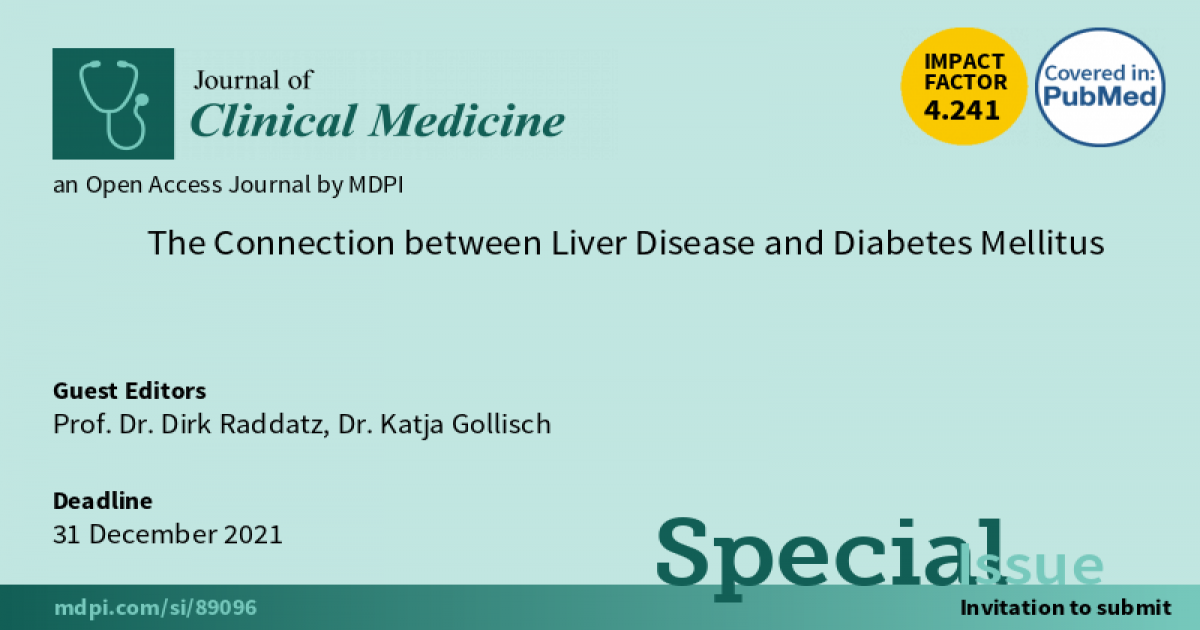The Connection between Liver Disease and Diabetes Mellitus
A special issue of Journal of Clinical Medicine (ISSN 2077-0383). This special issue belongs to the section "Endocrinology & Metabolism".
Deadline for manuscript submissions: closed (20 June 2022) | Viewed by 25051

Special Issue Editors
Interests: obesity; bariatric surgery; metabolic endoscopy; diabetes; metabolic syndrome; NAFLD
Special Issue Information
Dear Colleagues,
Liver disease in the context of the metabolic syndrome is part of the daily business in every GP practice, and the co-occurrence of fatty liver and type 2 diabetes mellitus (T2DM) is a frequent phenomenon. Non-alcoholic fatty liver disease (NAFLD) is the most common cause of chronic liver disease in Western nations, and the association of T2DM and fatty liver disease has led to immense costs in health care systems worldwide.
The liver, in its function as a central metabolic hub, plays a major role in maintaining glucose homeostasis. The relationship between liver disease and diabetes has been known for more than 100 years. At the end of the 19th century, the German physician Naunyn described the so-called “hepatogenic diabetes”. At that time, mainly alcohol and viral hepatitis were understood to cause liver cirrhosis with consecutive diabetes. Today the situation is regarded as much more complex. We know that metabolic pathologies like diabetes may lead to liver disease. Recently, the term metabolic-dysfunction-associated fatty liver disease (MAFLD) has been suggested to complement or replace the term NAFLD in order to emphasize the reciprocal relationship of metabolic disorders and liver disease.
Both T2DM and MAFLD are heterogeneous disorders that exhibit a wide range of different phenotypes. These phenotypes are most likely determined by different genetic and environmental factors as well as other as-yet unknown variables.
The aim of the planned Special Issue on Liver Disease and Diabetes Mellitus is to come one step closer to a personalized management for patients with MAFLD and T2DM. The more detailed the knowledge of underlying pathomechanisms, epidemiology, genetics, environmental factors, biomarkers, diagnostic procedures, and interventions, the more successful this will be.
We would like to invite you to help illuminate the way with your contribution. Original research papers, reviews, and case reports are welcome.
Prof. Dr. Dirk Raddatz
Dr. Katja Gollisch
Guest Editors
Manuscript Submission Information
Manuscripts should be submitted online at www.mdpi.com by registering and logging in to this website. Once you are registered, click here to go to the submission form. Manuscripts can be submitted until the deadline. All submissions that pass pre-check are peer-reviewed. Accepted papers will be published continuously in the journal (as soon as accepted) and will be listed together on the special issue website. Research articles, review articles as well as short communications are invited. For planned papers, a title and short abstract (about 100 words) can be sent to the Editorial Office for announcement on this website.
Submitted manuscripts should not have been published previously, nor be under consideration for publication elsewhere (except conference proceedings papers). All manuscripts are thoroughly refereed through a single-blind peer-review process. A guide for authors and other relevant information for submission of manuscripts is available on the Instructions for Authors page. Journal of Clinical Medicine is an international peer-reviewed open access semimonthly journal published by MDPI.
Please visit the Instructions for Authors page before submitting a manuscript. The Article Processing Charge (APC) for publication in this open access journal is 2600 CHF (Swiss Francs). Submitted papers should be well formatted and use good English. Authors may use MDPI's English editing service prior to publication or during author revisions.
Keywords
- Bariatric surgery
- MAFLD (metabolic dysfunction-associated fatty liver disease)
- NAFLD (non-alcoholic fatty liver disease)
- T2DM (type 2 diabetes mellitus)
- Insulin resistance
- Drug therapy
- Nutrition
- Inflammation
- Ultrasound elastography
- Metabolic endoscopy






